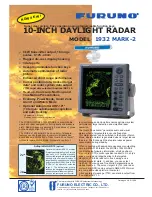
Sales Introduction – SAILOR 6222 VHF DSC Class A
Cobham SATCOM, 18 July 2013
Niels Peter Agdal
www.cobham.com
16
System configuration example – See the Installation manual for different installation
scenarios.
Please note: A comprehensive overview of different installation scenarios is available in the
Installation manual
5.1
Programming
When powering up the radio for the first time, the operator is asked to enter the MMSI
number. This can be done from the front of the VHF or via LAN. The number can be
changed (e.g. in case of a flag change) by connecting the SAILOR 6222 VHF via LAN to a PC
and browser (requires password). Additional private channels can also easily be programmed
from a PC using the LAN Cable that is connected to the LAN port of the VHF.
5.2
Connectors
Two antennas one for transmission and receiving and one for DSC
PWR Fuse: 12VDC power via the new power connector with integrated fuse
and a Power on signal to the external power supply
LAN: Ethernet/LAN for service tool, connectivity to other SAILOR 6000
products, printer and remote control.
ACC: For interface to external equipment such as
o
SAILOR 6201/03 Hand-set + Sailor 6202 Hand microphone
o
GPS in via NMEA 0183
CTRL:
o
This is the CAN bus connector port that drives the Control Speaker
Microphones.
AUX:
o
For VDR, GPS in via NMEA 0183, AUX OC (can be set to
independently), DSC Call, DSC Alarm, External Speaker, Low Power
Forced Control in eg. Oil/Gas installations






































